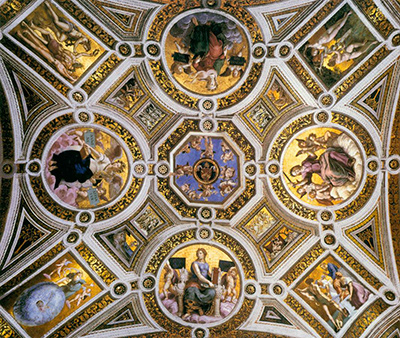Raphael, the young Italian artist, was commissioned by Pope Julius ll to decorate a suite of apartments in the Palace of the Vatican, Rome. The frescoes of The Stanza della Segnatura, completed from 1508 – 1511, are perhaps, Raphael’s best-known work.
All the walls and the ceiling are decorated with frescoes painted by Raphael, for the most part, unaided by his numerous assistants and students.
One long wall displays Disputa (Disputation of the Holy Sacrament), which shows a Heavenly vision of God surrounded by His prophets and apostles above a congregation of past and present members of the Roman Catholic Church.
Towards the right, partially hidden behind a church dignitary in a golden robe, stands a man wearing a laurel-leaf crown. He is the poet Dante whose famous poem Inferno reformed Italian literature and language.
The other long wall shows the School of Athens, which epitomises the artwork of the High Renaissance and is considered the most famous of Raphael's frescoes. The setting is defined by pilasters and vaults of a great basilica depicting the design of St. Peter's.
This scene shows an ordered gathering of groups of his fellow artists in the guise of famous philosophers, past and present, in a variety of poses. Leonardo da Vinci is depicted as Plato.
The eye of the viewer is drawn from each group to the next, and eventually to the figures of Plato and Aristotle in the central space. Part-way through this painting, Raphael viewed the work-in-progress by Michelangelo on the Sistine Chapel just down the hall. He was so impressed that he added a portrait of his contemporary as the philosopher Heraclitus, sitting on the steps. The overall impression of this fresco, which represents the truth acquired through reason, is one of civilised calm, clarity and balance.
The third fresco in the Stanza della Segnatura is named Parnassus, the domain of Apollo and the Muses and poetry according to classical mythology. There is a window in this wall with a view of the hill of the Vatican on which, in historical times, there was a shrine to Apollo and the arts. In this fresco, Apollo plays a lira while sitting under a grove with nine Muses who represent the arts. The scene is a celebration of poetry.
Cardinal and Theological Virtues
The fourth and final wall of the Stanza della Segnatura displays the Cardinal and Theological Virtues above the window opening. The cardinal virtues are represented by three women in a landscape, and the theological virtues are represented by cupids:
- Fortitude has a small lion in her lap and is holding an oak branch which is being shaken by the cupid, Charity.
- Prudence is a woman with two faces; one young, peering into a mirror, and the other old and bearded reflected back. The cupid, Hope holding a burning torch behind her.
- Temperance holds reins while guarding the cupid, Faith who points to the sky.
On the left of this wall, beside the window is the scene showing the Emperor Justinian surrounded by a jury as he receives the digests of the Corpus of Civil Laws from Tribonian. To the right of the window, is a portrait of Pope Julius II represented as the historical Pope Gregory IX seen approving a collection of decretals. Alongside, are other Cardinals; Alessandro Farnese and Giovanni de Medici are throne assistants, and Cardinal del Monte is to their left.
The Ceiling
Decorating the ceiling of the room is an intricate geometric arrangement of images based on the same theme as and complementing the four walls. The design of the ceiling is credited to Sodoma, but he only painted the octagonal centre and the spaces between the tondi. Raphael painted the figures personalising the concepts of Philosophy, Poetry, Theology, and Justice as well as the four panels in the corners.
Death and Legacy
Raphael died suddenly on his 37th birthday, of unexplained causes in Rome. He had been working on The Transfiguration; a large painting on canvas. Raphael was laid to rest at the Pantheon in Rome. After his death in 1520 Raphael’s painting style continued to be a strong influence during Italy’s Baroque period. Highly regarded for the harmonious compositions of his frescoes, portraits and architecture, Raphael is considered to be the artistic leader of High Renaissance classicism in Italy.




